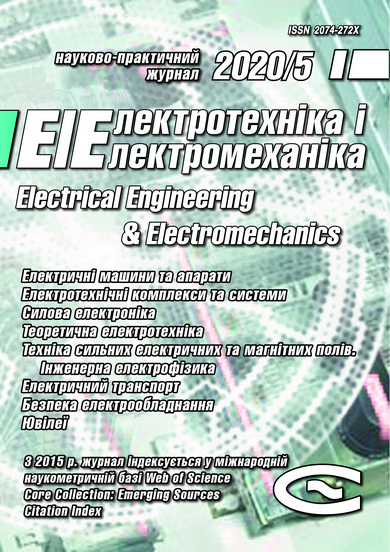CHALLENGES OF DYNAMIC SIMULATION OF HIGH-SPEED ELECTROMAGNETIC VALVES OF GAS DISTRIBUTION DEVICES
DOI:
https://doi.org/10.20998/2074-272X.2020.5.01Keywords:
high-speed electromagnets, dynamics, Finite Element Method, multiphysics, elastic meshAbstract
High-speed electromagnetic valves of gas distribution devices are used in modern missile and space technology as jet micro-motors of the executive elements of missile stabilization systems, as well as to control the movement of spacecrafts in space. The problem of creating such valves which are simple and reliable in the operation is relevant. In this work, it is proposed at the development and design stage to perform computer modelling of mutually coupled electromechanical processes, such as: distribution of transient electromagnetic field, transients in an electric circuit, and movement of an electromagnet armature. Besides, the calculation of the force with which the compressed gas acts on the corresponding structural elements of the valve is proposed to be performed by solving the system of Navier-Stokes equations. All problems are solved by numerical methods in axisymmetrical formulation with the corresponding initial and boundary conditions. Improvement of the accuracy of electromagnetic calculations and taking into account the movement of the armature of an electromagnet in the process of multiphysics numerical simulation is achieved using so-called tunable elastic meshes. The paper presents a comparative analysis of the numerical results obtained for several designs of electromagnets. The features of the dynamics of high-speed electromagnets of gas distribution valves during on and off operations are analyzed, the corresponding dynamic characteristics calculated using the proposed technique are presented.References
Olejnik V.P., Yelanskyi Yu.A., Kaluger L.G. Mathematical modelling of a gas distributor of the carrier rocket gas-jet control system. Space Technology. Missile Weapons, 2017, iss. 1 (113), pp. 59-66. (Rus).
BeliaevN.M., Belik N.P., Uvarov E.I. Jet Control Systems for Spacecrafts. Moscow, Mechanical Engineering Publ., 1979. 232 p. (Rus).
Bajda Ye.I., Klymenko B.V., Pantelyat M.G., Korol O.G., Yelanskyi Yu.A. Peculiarities of calculating forced electromagnets shunt windings heating in transient modes. Proceedings of the 18th International IGTE Symposium on Numerical Field Calculation in Electrical Engineering. Graz, Austria, September 2018, p. 31-36.
Bajda Ye.I., Klymenko B.V., Pantelyat M.G., Yelanskyi Yu.A., Trichet D., Wasselynck G. Peculiarities of calculating the dynamics of high-speed electromagnets using tunable elastic meshes. Proceedings of the 18th International Symposium on Electromagnetic Fields in Mechatronics, Electrical and Electronic Engineering (ISEF'2019). Nancy, France, August 2019. 6 p.
Zhang J.Z., Cai C.H., Wu C.G. Design and analysis of a new permanent magnet actuator for medium voltage vacuum circuit breakers. Applied Mechanics and Materials, 2013, vol. 313-314, pp. 20-26. doi: 10.4028/www.scientific.net/amm.313-314.20.
Bissal A., Magnusson J., Salinas E., Engdahl G. Multiphysics modeling and experimental verification of ultra-fast electro-mechanical actuators. International Journal of Applied Electromagnetics and Mechanics, 2015, vol. 49, no. 1, pp. 51-59. doi: 10.3233/jae-140176.
Bajda Ye.I., Klymenko B.V., Pantelyat M.G., Trichet D. Wasselynck G. Electromagnetic and thermal transients during induction heating of cylindrical workpieces. Acta Technica, 2018, vol. 63, no. 5, pp. 657-682.
Pantelyat M.G. Multiphysical numerical analysis of electromagnetic devices: state-of-the-art and generalization. Electrical Engineering & Electromechanics, 2013, no. 3, pp. 29-35.
Pantelyat M.G. Multiphysics in electromagnetic devices simulation and design: an attempt of generalization. Acta Technica, 2012, vol. 57, no. 2, pp. 127-142.
Pantelyat M.G., Shulzhenko N.G., Matyukhin Yu.I., Gontarowsky P.P., Doležel I., Ulrych B. Numerical simulation of electrical engineering devices: magneto-thermo-mechanical coupling. COMPEL: The International Journal for Computation and Mathematics in Electrical and Electronic Engineering, 2011, vol. 30, no. 4, pp. 1189-1204. doi: 10.1108/03321641111133127.
Pantelyat M.G., Féliachi M. Magneto-thermo-elastic-plastic simulation of inductive heating of metals. The European Physical Journal Applied Physics, 2002, vol. 17, no. 1, pp. 29-33. doi: 10.1051/epjap:2001001.
Podoltsev O.D., Kucheriava I.M. Multiphysics modeling of electrotechnical devices. Technical Electrodynamics, 2015, no. 2, pp. 3-15 (Rus).
Podoltsev O.D., Kucheriava I.M. Multiphysics modeling in electrical engineering. Kyiv, TheInstitute ofElectrodynamics of theNationalAcademy of Sciences ofUkraine Publ., 2015. 305 p. (Rus).
Stratton J.A. Electromagnetic Theory. NJ, Wiley, 2007. 640 p.
Meeker D. Improvised open boundary conditions for magnetic finite elements. IEEE Transactions on Magnetics, 2013, vol. 49, iss. 10, pp. 5243-5247. doi: 10.1109/tmag.2013.2260348.
Cizmas P.G.A., Gargoloff J.I. Mesh generation and deformation algorithm for aeroelasticity simulations. Journal of Aircraft, 2008, vol. 45, no. 3, pp. 1062-1066. doi: 10.2514/1.30896.
Dwight R.P. Robust mesh deformation using the linear elasticity equations. Computational Fluid Dynamics, 2006, pp. 401-406. doi: 10.1007/978-3-540-92779-2_62.
Downloads
Published
How to Cite
Issue
Section
License
Copyright (c) 2020 E. I. Baida, B. V. Klymenko, Michael G. Pantelyat, Yu. A. Yelanskyi, D. Trichet, G. Wasselynck

This work is licensed under a Creative Commons Attribution-NonCommercial 4.0 International License.
Authors who publish with this journal agree to the following terms:
1. Authors retain copyright and grant the journal right of first publication with the work simultaneously licensed under a Creative Commons Attribution License that allows others to share the work with an acknowledgement of the work's authorship and initial publication in this journal.
2. Authors are able to enter into separate, additional contractual arrangements for the non-exclusive distribution of the journal's published version of the work (e.g., post it to an institutional repository or publish it in a book), with an acknowledgement of its initial publication in this journal.
3. Authors are permitted and encouraged to post their work online (e.g., in institutional repositories or on their website) prior to and during the submission process, as it can lead to productive exchanges, as well as earlier and greater citation of published work.





